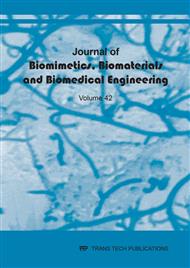[1]
A. Gefen, M.Megido-Ravid, Y. Itzchak, and M. Arcan, Analysis of muscular fatigue and foot stability during high-heeled gait. Gait & posture, 15 (2002), 56-63.
DOI: 10.1016/s0966-6362(01)00180-1
Google Scholar
[2]
C. Fritschi, and L. Quinn, Fatigue in patients with diabetes: a review. Journal of psychosomatic research, 69(2010), pp.33-41.
Google Scholar
[3]
R.M. Enoka, and J. Duchateau, Muscle fatigue: what, why and how it influences muscle function. The Journal of physiology, 586 (2008), pp.11-23.
DOI: 10.1113/jphysiol.2007.139477
Google Scholar
[4]
A. Koller, J. Mair, W. Schobersberger, T. Wohlfarter, C. Haid, M. Mayr, B. Villiger, W. Frey, and B. Puschendorf, Effects of prolonged strenuous endurance exercise on plasma myosin heavy chain fragments and other muscular proteins. Cycling vs running. The Journal of sports medicine and physical fitness, 38(1998), pp.10-17.
Google Scholar
[5]
G.C. Bogdanis, Effects of physical activity and inactivity on muscle fatigue. Frontiers in physiology, 3 (2012), p.142.
Google Scholar
[6]
A.M. Hunter, A.S.C. Gibson, M.I. Lambert, L. Nobbs, and T.D. Noakes, Effects of supramaximal exercise on the electromyographic signal. British journal of sports medicine, 37(2003), pp.296-299.
DOI: 10.1136/bjsm.37.4.296
Google Scholar
[7]
D. Roman-Liu, T. Tokarski, and K. Wójcik, Quantitative assessment of upper limb muscle fatigue depending on the conditions of repetitive task load. Journal of Electromyography and Kinesiology, 14(2004), pp.671-682.
DOI: 10.1016/j.jelekin.2004.04.002
Google Scholar
[8]
A.T. Nummela, K.A. Heath, L.M. Paavolainen, M.I. Lambert, A.S.C. Gibson, H.K. Rusko, and T.D. Noakes, T.D, Fatigue during a 5-km running time trial. International journal of sports medicine, 29 (2008), pp.738-745.
DOI: 10.1055/s-2007-989404
Google Scholar
[9]
M.R. Al-Mulla, F. Sepulveda, and M. Colley, A review of non-invasive techniques to detect and predict localised muscle fatigue. Sensors, 11(2011), pp.3545-3594.
DOI: 10.3390/s110403545
Google Scholar
[10]
M. Hu, T. Finni, M. Alen, J. Wang, L. Zou, W. Zhou, and S. Cheng, Myoelectrical manifestations of quadriceps fatigue during dynamic exercise differ in mono-and bi-articular muscles. Biology of Sport, 23(2006), pp.327-339.
Google Scholar
[11]
J. Mizrahi, O. Verbitsky, and E. Isakov, Fatigue-related loading imbalance on the shank in running: a possible factor in stress fractures. Annals of biomedical engineering, 28 (2000), pp.463-469.
DOI: 10.1114/1.284
Google Scholar
[12]
A. Mastalerz, L. Gwarek, J. Sadowski, and T. Szczepanski, The influence of the run intensity on bioelectrical activity of selected human leg muscles. Acta Bioeng Biomech, 14 (2012), pp.101-107.
Google Scholar
[13]
J.M. Zuniga, and M.H. Malek, Electromyographic responses of the superficial quadriceps femoris muscles during incremental treadmill running. Muscle & nerve, 48 (2013), pp.938-944.
DOI: 10.1002/mus.23842
Google Scholar
[14]
L.F. Crozara, A. Castro, A.F. De Almeida Neto, D.P. Laroche, A.C. Cardozo, and M. Gonçalves, Utility of electromyographic fatigue threshold during treadmill running. Muscle & nerve, 52 (2015), pp.1030-1039.
DOI: 10.1002/mus.24658
Google Scholar
[15]
N. Ridzuan, A. Azaman, K. Soeed, I. Zulkapri, and A.A. Wahab, Muscle Fatigue Evaluation using Non-invasive Infrared Thermography Technique with Assisted Electromyography: A Preliminary Study, International Medical Device and Technology Conference, 2017, 251-251.
DOI: 10.11113/mjfas.v13n4-2.823
Google Scholar
[16]
Garmin., United Kingdom., 2016, http://www.garmin.com/en-GB.
Google Scholar
[17]
A. Jeukendrup, and A.V. Diemen, Heart rate monitoring during training and competition in cyclists. Journal of Sports Sciences, 16(1998), pp.91-99.
DOI: 10.1080/026404198366722
Google Scholar
[18]
H.J. Hermens, B. Freriks, R. Merletti, D. Stegeman, J. Blok, G. Rau, C. Disselhorst-Klug and G. Hägg, European recommendations for surface electromyography. Roessingh research and development, 8(1999), pp.13-54.
Google Scholar
[19]
C.J. De Luca, L.D. Gilmore, M. Kuznetsov, and S.H. Roy, Filtering the surface EMG signal: Movement artifact and baseline noise contamination. Journal of biomechanics, 43(2010), pp.1573-1579.
DOI: 10.1016/j.jbiomech.2010.01.027
Google Scholar
[20]
M. Sarillee, M. Hariharan, M.N. Anas, M.I. Omar, M.N. Aishah, and Q.W. Oung, November. Assessment muscle fatigue using statistical study and classification: A review. In 2015 IEEE International Conference on Control System, Computing and Engineering (ICCSCE) (pp.206-211). IEEE.
DOI: 10.1109/iccsce.2015.7482185
Google Scholar
[21]
H. Xie and Z. Wang, Mean frequency derived via Hilbert-Huang transform with application to fatigue EMG signal analysis,, vol. 2, 2006, p.114–120.
DOI: 10.1016/j.cmpb.2006.02.009
Google Scholar
[22]
M. Hakonen, H. Piitulainen, and A. Visala, Current state of digital signal processing in myoelectric interfaces and related applications. Biomedical Signal Processing and Control, 18 (2015). 334-359.
DOI: 10.1016/j.bspc.2015.02.009
Google Scholar
[23]
M. Krzysztof, A. and Mero, A kinematics analysis of three best 100 m performances ever. Journal of human kinetics, 36(2013), pp.149-160.
DOI: 10.2478/hukin-2013-0015
Google Scholar
[24]
E. Bergamini, Biomechanics of sprint running: a methodological contribution (Doctoral dissertation, Arts et Métiers ParisTech), (2011).
Google Scholar


